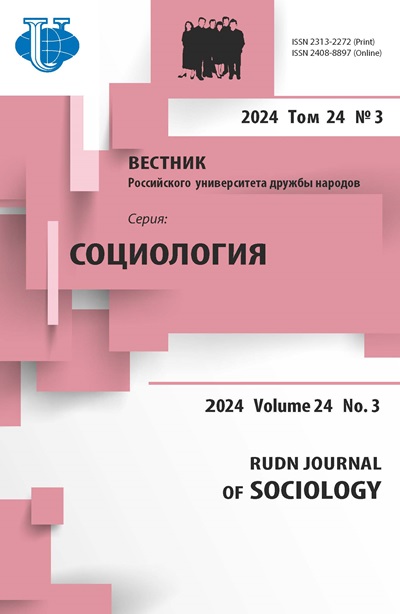Институты: многообещающая недостаточно раскрытая тема
- Авторы: Шубрт И.1
-
Учреждения:
- Карлов университет
- Выпуск: Том 22, № 2 (2022)
- Страницы: 249-258
- Раздел: Вопросы истории, теории и методологии
- URL: https://journals.rudn.ru/sociology/article/view/31341
- DOI: https://doi.org/10.22363/2313-2272-2022-22-2-249-258
Цитировать
Полный текст
Аннотация
Один из главных вопросов социологии звучит так: какой набор правил и какой тип порядка создают общество и как именно они сохраняются. Один из возможных ответов на этот вопрос основан на понятии института, которое до сих порождает теоретические дискуссии, в том числе вследствие неоднозначности данного термина: образно говоря, научное понятие «институт» все еще окутано туманом, который не позволяет дать ему однозначное и четкое определение. Сегодня многие дисциплины претендуют на решение этой проблемы вне социологического контекста - философия, политология, антропология и даже математическая теория игр, однако лишь усугубляют противоречия, связанные с концепцией институтов. Некоторые теоретические подходы склоняются к определению института как своего рода кибернетического черного ящика с системой входов и выходов, чье функционирование носит преимущественно скрытый характер (философские и математические модели стремятся обнаружить в деятельности институтов некий общий универсальный принцип или даже математическую формулу). Статья рассматривает понятие института с точки зрения общей социологической теории. Автор считает, что концепция институтов - главная социологическая теория, требующая сегодня принципиального переосмысления. Отправной точкой рассуждений автора выступает анализ концептуальных подходов к трактовке института, предлагающих его разные определения и допускающих парадигматическую интеграцию. Затем автор кратко характеризует теоретические подходы Питера Бергера, Томаса Лукмана и Джона Серля, а также понятия, пришедшие в социологию из теорий игр и теорий рационального поведения. Далее в статье обозначены десять вопросов, вытекающих из существующих социологических теорий институтов. Автор подчеркивает, что среди них очевидно доминирование методологического индивидуализма, что объясняет принципиальное игнорирование целого ряда вопросов холистического и макросоциального характера и неизбежно порождает упрощения. В статье намечены направления дальнейшей работы - что следует изменить в сложившейся трактовке института в социальных науках, чтобы выработать адекватные основания для его осмысления в рамках социологической теории.
Об авторах
Иржи Шубрт
Карлов университет
Автор, ответственный за переписку.
Email: jiri.subrt@ff.cuni.cz
доктор философии, профессор факультета гуманитарных наук
У Криже, 8, Прага 5, 15800, ЧехияСписок литературы
- Berger P.L., Luckmann T. Sociální konstrukce reality: Pojednání o sociologii vědění. Brno; 1999.
- Burns T.R., Dietz T. Social rule systems and human agency. International Sociology. 1992; 1 (7).
- Coleman J.S. Foundations of Social Theory. Cambridge; 1994.
- Elias N. The Court Society. Oxford; 1983.
- Elias N. The Civilizing Process: The History of Manners and State Formation and Civilization. Oxford; 1994.
- Esser H. Soziologie, Spezielle Grundlagen. Band 5: Institutionen. Frankfurt/New York; 2000.
- Gehlen A. Anthropologische Forschung. Rowohlt; 1961.
- Giddens A. Time and space in social theory. Matthes J. (Ed.). Lebenswelt und soziale Probleme. Frankfurt/Main; 1981.
- Giddens A. The Constitution of Society: Outline of the Theory of Structuration. Berkeley - Los Angeles; 1957.
- Guala F. Précis of “Understanding Institutions”. Philosophy of Social Sciences. 2018; 48 (6).
- Keller J. Úvod do sociologie. Praha; 1991.
- Lévi-Strauss C. Anthropologie structurale. Paris; 1985.
- Luhmann N. Die Ausdifferenzierung des Kunstsystems. Bern; 1994.
- Nash J.F. Equilibrium points in n-person games. In: Proceedings of the National Academy of Sciences of the United States of America. 1950; 36 (1).
- von Neumann J., Morgenstern O. Theory of Games and Economic Behavior. Princeton; 1953.
- Parsons T. On Institutions and Social Evolution. Selected Writings. Ed. and with intr. by L.H. Mayhew. Chicago - London; 1982.
- Rueschemeyer D. Usable Theory: Analytic Tools for Social and Political Research. Princeton - Oxford; 2009.
- Searle J.R. Intentionality: An Essay in the Philosophy of Mind. Cambridge; 1983.
- Searle J.R. Collective intentions and actions. Cohen P.R., Morgan J., Pollack M. (Eds.). Intentions in Communication. Cambridge; 1990.
- Searle J.R. The Construction of Social Reality. New York; 1997.
- Spencer H. The Principles of Sociology. Vol. 1-2. New York; 1897.
- Šubrt J. Individualism, Holism and the Central Dilemma of Sociological Theory. Bingley; 2019.
- Tegtmeier E. Soziologie und Ontologie der Institution. Schönrich G. (Ed.). Institutionen und ihre Ontologie. Frankfurt am Main; 2005.
- Turner J.H. Human Institutions: A Theory of Societal Evolution. Lanham; 2003.
- Turner J.H. Theoretical Principles of Sociology. Vol. 1: Macrodynamics. New York; 2010.
- Turner J.H. Theoretical Principles of Sociology. Vol. 3: Mesodynamics. New York; 2012.














